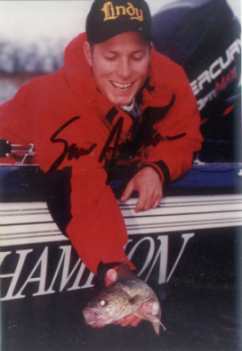 |
|
|
|
By Sam Anderson Jigging, still fishing with live bait and casting are the three most
popular methods used to fish current breaks. Vertical jigging is
the most popular of the three.
By noting the precise location from which the first couple of fish are taken, current break anglers can accurately predict the mood of the fish on a given day. If the fish comes from the dead or slack water directly below the obstruction, chances are good they are resting and inactive. A limit will not come easily under these conditions. If the fish come from above the obstruction, on the very edge of the current or from the eddy below the break, it is an indication the fish are active. Methodically checking out every foot of suspended fish holding water
near a current break will pay the highest dividends. First check
out the upstream lip and the downstream edge where current and slack water
meet. These are the areas that will hold active fish. If there
is nothing doing at the these locations, give the dead water directly behind
the obstruction a quick going over to entice any inactive fish which might
be present. Don’t waste a lot of time on one site just because it
looks good. Move on and come back later to check it out
Vertical fishing also makes it easier to fish a small area, such as a brushpile, hump or other structure. You can often cast to within 5 feet of such an area and not get hit, but put your lure in it and you immediately come up with a fish. My favorite technique is to use my Fish are unusually spooky along wingdams and noisy gas engines will
spook the fish. I prefer to use quieter electric motors, like my
bow mount MotorGuide. The key element here is presentation,
to keep the bait in front of the fish. Point the bow into the
current and "slip" down at about current speed. Keep baits in the
strike zone longer by sweeping the baits across the structure allowing
the bait to fall at a slow rate to naturally present the bait to the fish.
It is essential,
In most situations you should be able to get by with four jig sizes, usually fewer than that. On most lakes, rivers, and reservoirs, you should almost always be able to get by with a selection of 1/16, 1/8, 1/4, and 3/8 ounce jigs. True, in some rivers you will need heavier jigs and below a slip bobber a lighter one might work best, but day in and day out, on most waters, these four sizes will be completely adequate. I use more 1/8-ounce size than any other, and lately I have been using more of the 1/16-ounce size. Use plastic bodies to slow the fall of the jig, to add bulk and visibility in stained and dirty water, and to add color. I like to use a plastic body of one color with a jighead of another color. That provides contrast and also increases the chance of showing the fish the color they want. Pink/ white and orange/ chartreuse are favorite color combinations. Keep in mind that the walleye's vision will be impaired in the darker
environment. Fluorescent colors will often be more productive in
this condition. In the spring and summer I like to use plastic bodied
jigs like the Please visit these site sponsors |
|---|---|
 Current
is the number one factor when it comes to determining fish location on
the river. During most of the spring the water will be high enough
to greatly restrict the areas walleyes will inhabit. By June, water
levels will have stabilized somewhat, but savvy anglers continue to focus
their attention on areas where the current is diverted. Some types of current
breaks are obvious, even to the beginning angler. Bridge pilings,
fallen trees, the ever popular wingdams,
Current
is the number one factor when it comes to determining fish location on
the river. During most of the spring the water will be high enough
to greatly restrict the areas walleyes will inhabit. By June, water
levels will have stabilized somewhat, but savvy anglers continue to focus
their attention on areas where the current is diverted. Some types of current
breaks are obvious, even to the beginning angler. Bridge pilings,
fallen trees, the ever popular wingdams,